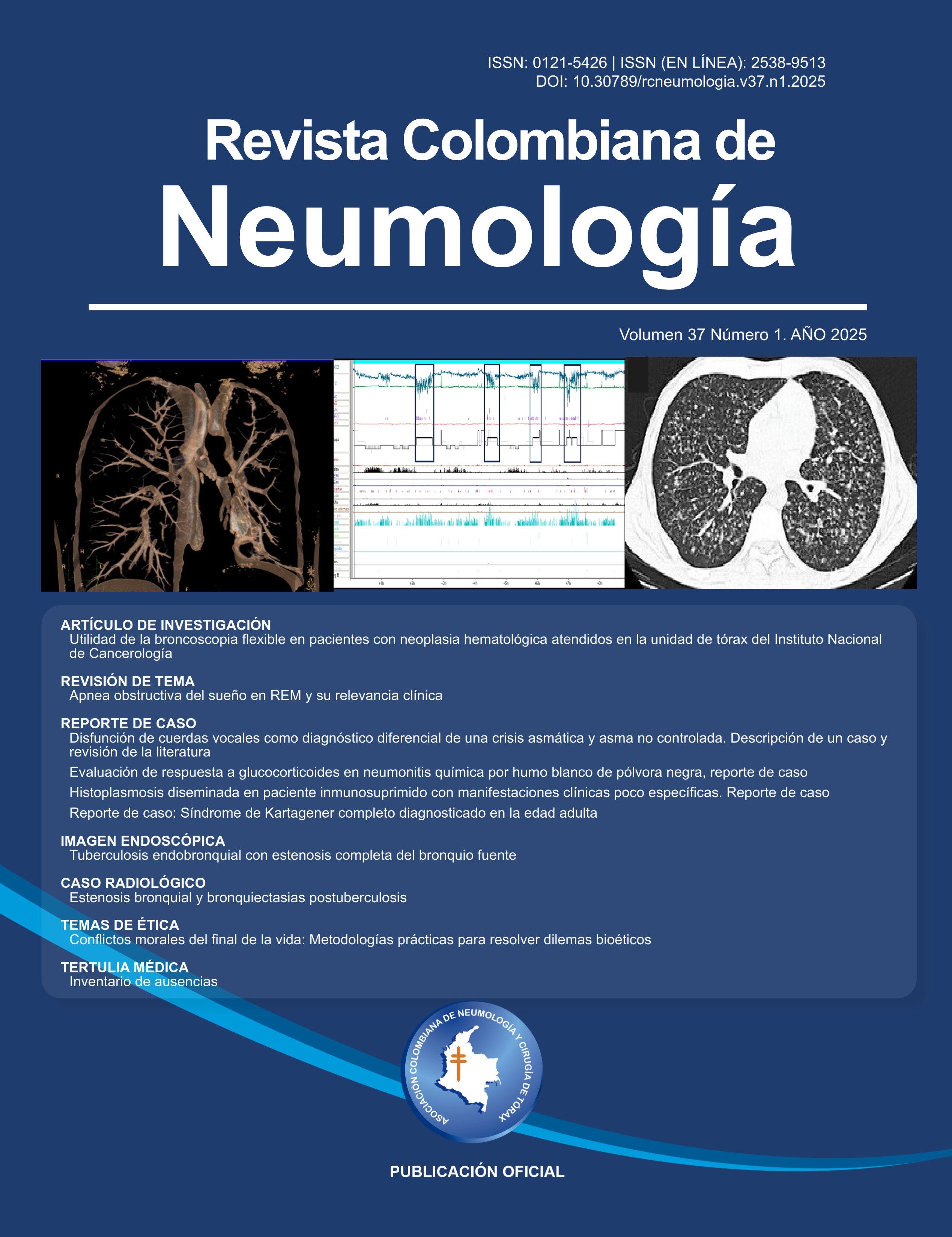Response evaluation to glucocorticoids in chemical pneumonitis due to white, black gunpowder smoke, case report
Evaluación de respuesta a glucocorticoides en neumonitis química por humo blanco de pólvora negra, reporte de caso

This work is licensed under a Creative Commons Attribution-NonCommercial-ShareAlike 4.0 International License.
Ninguna publicación, nacional o extranjera, podrá reproducir ni traducir sus artículos ni sus resúmenes sin previa autorización escrita del editor; sin embargo los usuarios pueden descargar la información contenida en ella, pero deben darle atribución o reconocimiento de propiedad intelectual, deben usarlo tal como está, sin derivación alguna.
Show authors biography
Historically, different types of explosives have been used in mining. Black gunpowder is the most widely used, comprising carbon, sulfur, and potassium nitrate. Knowing that the fumes emitted after an explosion are highly toxic is essential. Chemical pneumonitis resulting from the inhalation of pyrotechnic smoke (black powder) is associated with the various products of its combustion, where potassium compounds are predominant and highly toxic. We report the case of a man in his third decade of life who, working as a miner, was exposed to the inhalation of white smoke from black powder for an approximate time of 10 minutes with the subsequent appearance of signs of respiratory difficulty and pulmonary involvement that was demonstrated. Through imaging (x-ray and chest tomography), bilateral inflammatory lung involvement at the interstitial level is observed secondary to inhaled toxins, and after the initiation of early corticosteroid therapy, adequate resolution of the interstitial lung involvement is documented, accompanied by an adequate clinical and respiratory response.
Article visits 229 | PDF visits 102
Downloads
- Woodson LC, Branski LK, Enkhbaatar P, Talon M. Diagnosis and treatment of inhalation injury. En: Herndon DN, editor. Total burn care. 5th ed. Elsevier; 2018. p. 184-194.e3. doi: 10.1016/B978-0-323-47661-4.00017-4. DOI: https://doi.org/10.1016/B978-0-323-47661-4.00017-4
- Navarro RF, Carrillo RS, Ochoa SH, Ortega MJ. Neumonitis química secundaria a inhalación accidental de heptano. Acta Méd Grupo Ángeles [Internet]. 2018;16(4):353-356. Disponible en: http://www.scielo.org.mx/scielo.php?script=sci_arttext&pid=S1870-72032018000400353&lng=es
- Kot P, Morales Sarabia JE, Rovira Soriano L, De Andrés Ibáñez J. Proposal for an algorithm for the management of the patient's airway after smoke inhalation. Rev Esp Anestesiol Reanim (Engl Ed). 2018;65(3):170-172. doi: 10.1016/j.redare.2017.12.010. DOI: https://doi.org/10.1016/j.redare.2017.12.010
- Dries DJ, Endorf FW. Inhalation injury: epidemiology, pathology, treatment strategies. Scand J Trauma Resusc Emerg Med. 2013 Apr 19;21:31. doi: 10.1186/1757-7241-21-31. PMID: 23597126; PMCID: PMC3653783. DOI: https://doi.org/10.1186/1757-7241-21-31
- Sen S, Greenhalgh D, Palmieri T. Review of burn research for the year 2010. J Burn Care Res. 2012;33:577-586. doi: 10.1097/BCR.0b013e3182644fba. DOI: https://doi.org/10.1097/BCR.0b013e3182644fba
- Hassan Z, Wong JK, Bush J, Bayat A, Dunn KW. Assessing the severity of inhalation injuries in adults. Burns. 2010;36:212-216. doi: 10.1016/j.burns.2009.06.205. DOI: https://doi.org/10.1016/j.burns.2009.06.205
- Howard MO, Bowen SE, Garland EL, Perron BE, Vaughn MG. Inhalant use and inhalant use disorders in the United States. Addict Sci Clin Pract. 2011 Jul;6(1):18-31. PMID: 22003419; PMCID: PMC3188822. https://www.ncbi.nlm.nih.gov/pmc/articles/PMC3188822/pdf/ascp-06-1-18.pdf.
- Rehberg S, Maybauer MO, Enkhbaatar P, Maybauer DM, Yamamoto Y, Traber DL. Pathophysiology, management and treatment of smoke inhalation injury. Expert Rev Respir Med. 2009;3(3):283-297. doi: 10.1586/ers.09.21. DOI: https://doi.org/10.1586/ers.09.21
- Walker PF, Buehner MF, Wood LA, Boyer NL, Driscoll IR, Lundy JB, Cancio LC, Chung KK. Diagnosis and management of inhalation injury: an updated review. Crit Care. 2015 Oct 28;19:351. doi: 10.1186/s13054-015-1077-4. DOI: https://doi.org/10.1186/s13054-015-1077-4
- Enkhbaatar P, Pruitt BA Jr, Suman O, Mlcak R, Wolf SE, Sakurai H, Herndon DN. Pathophysiology, research challenges, and clinical management of smoke inhalation injury. Lancet. 2016 Oct 1;388(10052):1437-1446. doi: 10.1016/S0140-6736(16)31458-1. DOI: https://doi.org/10.1016/S0140-6736(16)31458-1







